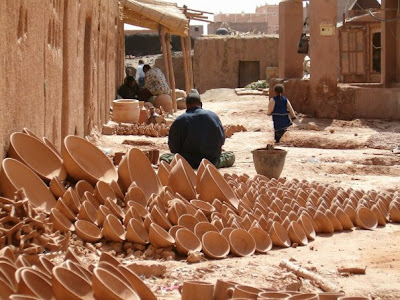
TAMEGROUTE is an interesting and unusual village. At first sight, it is basically a group of
ksour and kasbahs, wedged tightly together and divided by low, covered passageways with an unremarkable Saturday souk and small potters'co-operative. Despite appearances, it was once the most important settlement in the
Draa valley, it appearances, it was once the most important settlement in the
Draa valley; it appears on nineteenth-century maps -produced in Europe - as Tamgrat or Tamagrut, surrounded by lesser places whose names have little or no resonance today.
It owes its importance to its ancient and highly prestigious zaouia, which was a seat of learning from the eleventh century and, from the seventeenth century, the base of the Naciri Brotherhood. Founded by Abou Abdallah Mohammed Ben Naceur (an inveterate traveller and revered scholar), this exercised great influence over the Draa tribes until recent decades. Its sheikhs (or holy leaders) were known as the "peacemakers of the desert " and it was they who settled disputes among the ksour and among the caravan traders converging on
Zagora from the Sudan. They were missionaries, too, and as late as the 1750s sent envoys to preach to and convent the wilder, animist-minded Berber tribes of the Atlas and Rif.
Arriving in the village, you'll likely be "adopted" by a guide and taken off to see the Zaouia Naciri (8am-12.30pm and 2-6pm daily; donations expected), the entrance to which is on a side-street to the left of the main road (coming from Zagora).If you are not 'adopted' or prefer to explore unaided, look for the tall white minaret to the left of the main road.
The zaouia consists of a marabout (the tomb of Naceur, closed to non-Muslims), a medersa (theological college - still used by up to 80 students, preparing for university) and a small libary, which welcomes non-Muslim visitors and where you will see illuminated korans, some on animal hides, as well as twelfth-century works on mathematics, medicine and history. The sanctuary, as for centuries past, is a refuge for the sick and mentally ill, whom you'll see sitting round in the courtyard; they come in the hope of miraculous cures and/or to be supported by the charity of the brotherhood and other benevolent visitors.
The library was once the richest in
Morocco, containing 40,000 volumes. Most have been dispersed to Koranic Shools round the country, but Tamegroute preserves a number of very early editions of the koran printed on gazelle hide, and some interesting books, including a thirteenth-century algebra primer featuring western Arabic numerals, which, although subsequently dropped in the Arab world, formed the basis of the West's numbers, through the influence of the universities of Moorish Spain.
The potter's cooperative is on the left as you leave Tamegroute
travelling towards Tinfou. Visitors are welcome(Mon-Fri, 7am) and there is no pressure to buy. If you want to see the production of pottery in its simplest form, you will find this an ideal opportunity. Do not be surprised to find the green glaze, on finished items, reminiscent of
Fes pottery. This is no accident; the founders of the Naciri Brotherhood wanted to develop Tamegroute - to city status, they hoped. Thus, they invited merchants and craftsmen from
Fes to settle in Tamgroute. Two families, still working in the pottery, claim Fes forebears.
More recently, in 1995, the pottery enjoyed further patronage, in the form of a state grant to purchase two gas-fired kilns. This is part of a project to revive the fortunes of the
Draa valley. You will see elegant bowls thrown from the local clay on a foot-operated wheel and then the sun-dried "biscuit" stacked in seven traditional kilns built into the slop. Spinifex (known locally as jujube) and sagebrush raise the temperature to 1000°C, producing the green-glazed ware in a single firing. The minerals for the glaze colour are found locally (copper) and near Tata (manganese).
Private Morocco Tours




